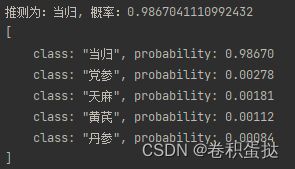Java调用Pytorch模型进行图像识别
之前写了个输入是1x2向量的模型的调用文章,后来有了个需要用到图像识别的项目,因此写下此文记录一下在java中如何借助DJL调用自己写的pytorch模型进行图像识别。
官网例子
我具体模型用的什么模型就不介绍了,输入图片是3*224*224,放入图片前需要看一下横纵比是否合理,不合理的话会进行下面这样的操作:
1. 依赖
ai.djl.pytorch
pytorch-engine
0.16.0
ai.djl.pytorch
pytorch-native-auto
1.9.1
runtime
2. 准备模型
- 首先将模型按下面方法保存,放到项目resources中
import torch
# An instance of your model.
model = MyModel(num_classes = 80)
# Switch the model to eval model
model.eval()
# An example input you would normally provide to your model's forward() method.
example = torch.rand(1, 3, 224, 224)
# Use torch.jit.trace to generate a torch.jit.ScriptModule via tracing.
traced_script_module = torch.jit.trace(model, example)
# Save the TorchScript model
traced_script_module.save("model.pt")- 编写工具类,用于完成识别功能
public class HerbUtil {
//规定输入尺寸
private static final int INPUT_SIZE = 224;
//标签文件 一种类别名字占一行
private List herbNames;
//用于识别
Predictor predictor;
//模型
private Model model;
public HerbUtil() {
//加载标签到herbNames中
this.loadHerbNames();
//初始化模型工作
this.init();
}
} - 将标签文件放到resources中,载入标签
private void loadHerbNames() {
BufferedReader reader = null;
herbNames = new ArrayList<>();
try {
InputStream in = HerbUtil.class.getClassLoader().getResourceAsStream("names.txt");
reader = new BufferedReader(new InputStreamReader(in));
String name = null;
while ((name = reader.readLine()) != null) {
herbNames.add(name);
}
System.out.println(herbNames);
} catch (Exception e) {
e.printStackTrace();
} finally {
if (reader != null) {
try {
reader.close();
} catch (IOException e) {
e.printStackTrace();
}
}
}
}- 初始化模型
private void init() {
Translator translator = ImageClassificationTranslator.builder()
//下面的transform根据自己的改
.addTransform(new RandomResizedCrop(INPUT_SIZE, INPUT_SIZE, 0.6, 1,
3. / 4, 4. / 3))
.addTransform(new ToTensor())
.addTransform(new Normalize(
new float[] {0.5f, 0.5f, 0.5f},
new float[] {0.5f, 0.5f, 0.5f}))
//如果你的模型最后一层没有经过softmax就启用它
.optApplySoftmax(true)
//载入所有标签进去
.optSynset(herbNames)
//最终显示概率最高的5个
.optTopK(5)
.build();
//随便起名
Model model = Model.newInstance("model", Device.cpu());
try {
InputStream inputStream = HerbUtil.class.getClassLoader().getResourceAsStream("model.pt");
if (inputStream == null) {
throw new RuntimeException("找不到模型文件");
}
model.load(inputStream);
predictor = model.newPredictor(translator);
} catch (Exception e) {
e.printStackTrace();
}
} - 我开头提到的图片预处理 的代码
private Image resizeImage(InputStream inputStream) {
BufferedImage input = null;
try {
input = ImageIO.read(inputStream);
} catch (IOException e) {
e.printStackTrace();
}
int iw = input.getWidth(), ih = input.getHeight();
int w = 224, h = 224;
double scale = Math.min(1. * w / iw, 1. * h / ih);
int nw = (int) (iw * scale), nh = (int) (ih * scale);
java.awt.Image img;
//只有太长或太宽才会保留横纵比,填充颜色
boolean needResize = 1. * iw / ih > 1.4 || 1. * ih / iw > 1.4;
if (needResize) {
img = input.getScaledInstance(nw, nh, BufferedImage.SCALE_SMOOTH);
} else {
img = input.getScaledInstance(INPUT_SIZE, INPUT_SIZE, BufferedImage.SCALE_SMOOTH);
}
BufferedImage out = new BufferedImage(INPUT_SIZE, INPUT_SIZE, BufferedImage.TYPE_INT_RGB);
Graphics g = out.getGraphics();
//先将整个224*224区域填充128 128 128颜色
g.setColor(new Color(128, 128, 128));
g.fillRect(0, 0, INPUT_SIZE, INPUT_SIZE);
out.getGraphics().drawImage(img, 0, needResize ? (INPUT_SIZE - nh) / 2 : 0, null);
ByteArrayOutputStream outputStream = new ByteArrayOutputStream();
try {
ImageOutputStream imageOutputStream = ImageIO.createImageOutputStream(outputStream);
ImageIO.write(out, "jpg", imageOutputStream);
//去D盘看效果
//ImageIO.write(out, "jpg", new File("D:\\out.jpg"));
InputStream is = new ByteArrayInputStream(outputStream.toByteArray());
return ImageFactory.getInstance().fromInputStream(is);
} catch (IOException e) {
e.printStackTrace();
throw new RuntimeException("图片转换失败");
}
}- 识别功能
public List predict(InputStream inputStream) {
List result = new ArrayList<>();
Image input = this.resizeImage(inputStream);
try {
Classifications output = predictor.predict(input);
System.out.println("推测为:" + output.best().getClassName()
+ ", 概率:" + output.best().getProbability());
System.out.println(output);
result = output.topK();
} catch (Exception e) {
e.printStackTrace();
}
return result;
} 3. 测试
@Test
public void test7() {
HerbUtil herbUtil = new HerbUtil();
String path = "E:\\深度学习专用\\data\\train\\当归\\24.jpeg";
try {
File file = new File(path);
InputStream inputStream = new FileInputStream(file);
herbUtil.predict(inputStream);
} catch (Exception e) {
e.printStackTrace();
}
}输出:
加入到项目中后,工具类直接Autowire注入或者方法都写static的,Controller接收前端MultipartFile,将其inputstream用于推测
如果你想加载网络图片,那就去网上搜索怎么把它转成inputstream吧
测试多线程一起predict时报错了
更新
当我打包成jar到centos7的linux中运行时,报错UnsatisfiedLinkError,经过大神的指导,问题出来我引的依赖。
修改后的依赖:
8
5.3.0
ai.djl.pytorch
pytorch-engine
0.16.0
ai.djl.pytorch
pytorch-native-cpu-precxx11
linux-x86_64
1.9.1
runtime
ai.djl.pytorch
pytorch-jni
1.9.1-0.16.0
runtime
org.springframework.boot
spring-boot-starter-web

